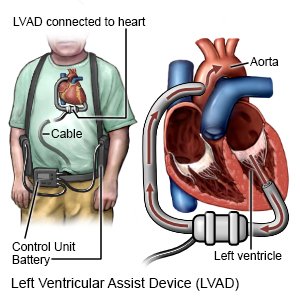Lvad (Left Ventricular Assist Device)
Medically reviewed by Drugs.com. Last updated on May 6, 2024.
What is an LVAD?
An LVAD is a pump that is attached to your heart. It helps the heart pump more blood. The pump keeps taking blood from the left ventricle and moving it to the aorta. The aorta then pumps the blood that contains oxygen to your body.
What are the parts of an LVAD?
An LVAD has parts that are implanted in your body. These parts include the pump and the tube that carries the blood to your aorta. A cable comes through your skin from the pump. The cable is called a driveline and is connected to a controller and power sources. Power sources may include batteries or electricity. The driveline, the controller, and the power sources must always be connected to keep the pump running.
 |
What do I need to know about LVAD implant surgery?
Your healthcare provider has recommended LVAD implant surgery because you are in late stages of heart failure and:
- You are waiting for a heart transplant. This is called Bridge to Transplant. The LVAD will stay in place until a donor is available.
- You are not a candidate for a heart transplant. The LVAD stays in place permanently. This is called Destination Therapy.
- Rarely, the LVAD is implanted to give your heart a rest while it regains its strength. The heart failure is temporary. This is called Bridge to Recovery.
What will happen before LVAD implant surgery?
- You may be admitted to the hospital days before the surgery is scheduled. You may instead already be in the hospital due to heart failure problems. Your healthcare provider will order several different tests, such as an echocardiogram and blood tests.
- You will meet a coordinator who will teach you about the LVAD. He or she will teach you how to take care of the parts that are outside of your body. A family member or friend must learn about your device so he or she can help you. You will be given a lot of information about your LVAD. Some information will be videos and some will be written.
What will happen during surgery?
- You will be given anesthesia to keep you asleep and pain-free during your surgery. You will be put on a ventilator to breathe for you during your surgery.
- The surgeon will make an incision through your breastbone. A heart-lung machine will be attached to your heart. The machine will circulate blood for your heart and lungs during surgery. This machine is also called a bypass machine.
- Your surgeon will decide what type of device is right for you. Some type of pumps are placed right next to your heart. For others, the surgeon will create a pocket of tissue just below your heart and diaphragm. The pocket will hold the pump.
- The driveline will be connected to the pump. It is brought through an incision in your abdomen. Then it is connected to the controller and power source. You will be weaned off of the heart-lung machine. The incision in your chest will be closed.
What will happen after surgery?
- You will be taken to the intensive care unit (ICU) to recover from surgery. You will be monitored very closely for any problems. You may remain on the ventilator until your lungs are working properly. Physical and occupational therapists will work with you to help you increase your strength. You will meet with a dietitian to discuss a heart healthy diet. You will be transferred to a cardiac unit after about 5 days to continue recovering.
- Your coordinator will continue to teach you about your device. He or she will teach you:
- How your device works and about the alarms
- What you need to do daily, weekly, and monthly to the device
- How to recognize changes or complications
- Your coordinator will tell your electric company and emergency services in your area that you have an LVAD. The electric company will put you on a priority list to fix your power quickly if it goes out. Your coordinator will also confirm that you have access to reliable telephone service.
What are the risks of LVAD surgery?
You may bleed more than expected during surgery or within 14 days of surgery. You may develop a blood clot that could cause a stroke. You may get an infection at the surgery sites. Blood clots, bleeding, and infection can become life-threatening.
Care Agreement
You have the right to help plan your care. Learn about your health condition and how it may be treated. Discuss treatment options with your healthcare providers to decide what care you want to receive. You always have the right to refuse treatment. The above information is an educational aid only. It is not intended as medical advice for individual conditions or treatments. Talk to your doctor, nurse or pharmacist before following any medical regimen to see if it is safe and effective for you.© Copyright Merative 2024 Information is for End User's use only and may not be sold, redistributed or otherwise used for commercial purposes.
Further information
Always consult your healthcare provider to ensure the information displayed on this page applies to your personal circumstances.
